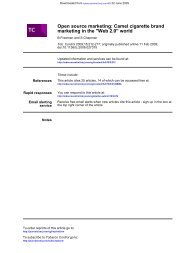National Cancer Prevention Policy - Tobacco Control Supersite
National Cancer Prevention Policy - Tobacco Control Supersite
National Cancer Prevention Policy - Tobacco Control Supersite
Create successful ePaper yourself
Turn your PDF publications into a flip-book with our unique Google optimized e-Paper software.
•<br />
•<br />
•<br />
•<br />
•<br />
•<br />
•<br />
•<br />
•<br />
•<br />
people with chronic liver disease and/or hepatitis C (who are seronegative for<br />
hepatitis B)<br />
residents and staff of facilities for people with intellectual disabilities<br />
people adopting children from overseas<br />
liver transplant recipients (who are seronegative for hepatitis B)<br />
inmates and staff of long-term correctional facilities<br />
healthcare workers, ambulance personnel, dentists, embalmers, tattooists and bodypiercers<br />
police, members of the armed forces and emergency services staff if at risk of exposure<br />
to body fluids<br />
funeral workers and other workers who have regular contact with human tissue, blood<br />
or body fluids and/or used needles or syringes<br />
people travelling to regions of intermediate or high endemicity, either long term or for<br />
frequent short terms<br />
sex industry workers.<br />
Although vaccine-induced antibody levels decline with time and may become<br />
undetectable, booster doses are not recommended in immuno-competent individuals after<br />
a primary course, as there is good evidence that a completed primary course of hepatitis<br />
B vaccination provides long-lasting protection (NHMRC 2008; Williams 2002). This applies<br />
to children and adults, including those at risk of occupational exposure, such as healthcare<br />
workers and dentists (Fitzsimons et al. 2005; Petersen et al. 2004).<br />
During the late 1980s, perinatal transmission of hepatitis B was recognised as the major<br />
factor leading to virus persistence and chronic liver disease and HCC. Vaccination of<br />
newborn infants of mothers with chronic hepatitis B infection was shown to be effective in<br />
reducing viral transmission, especially if combined with administration of ‘hyperimmune’<br />
hepatitis B immunoglobulin (HBIG) at birth. Hepatitis B vaccine given in combination with<br />
one dose of HBIG to babies within 12–24 hours after birth is around 85% to 95% effective<br />
in preventing hepatitis B infection (Beasley et al. 1983; Chang & Chen 2002; Kripke 2007;<br />
Lee et al. 2006; Petersen et al. 2004; WHO 2004; Yu, Cheung & Keeffe 2004). In Australia,<br />
all antenatal women are tested for hepatitis B or the hepatitis B status of mother is<br />
determined upon presentation in labour if unknown. Infants born to hepatitis B surfaceantigen-positive<br />
mothers or those of unknown status should receive HBIG at birth as well<br />
as the hepatitis B vaccine.<br />
The effect of vaccination on carriage rates in vaccinated age cohorts has been reported<br />
in many countries (Chang 2003; Chang et al. 2005; Chang & Chen 2002; Clements et al.<br />
2006; Chen 2005; Yu, Cheung & Keeffe 2004). More time must elapse before these cohorts<br />
reach the age of greatest HCC prevalence, but already some countries with previously<br />
very high HCC rates, such as Taiwan, have observed statistically significant reductions in<br />
young, vaccinated age groups (Chang & Chen 2002; Yuen et al. 2004). Taiwan introduced<br />
a universal hepatitis B vaccination program for infants in 1984; while HCC is uncommon in<br />
children, the reported incidence of HCC fell by 75% in children aged six to nine years who<br />
were born after the program started (Chang 2003; Lee, Hsieh & Ko 2003).<br />
The use of the hepatitis B vaccine and HBIG has been shown to be cost effective even<br />
in countries such as Australia with a low prevalence of hepatitis B. In the late 1990s, the<br />
World Health Organization advised the introduction of universal vaccination for all infants<br />
born in countries where the prevalence of chronic hepatitis B infection exceeded 2%.<br />
However, universal hepatitis B vaccination has been undertaken only sporadically in many<br />
<strong>National</strong> <strong>Cancer</strong> <strong>Prevention</strong> <strong>Policy</strong> 2007 – 09<br />
1 3<br />
H e p a t i t i s B




